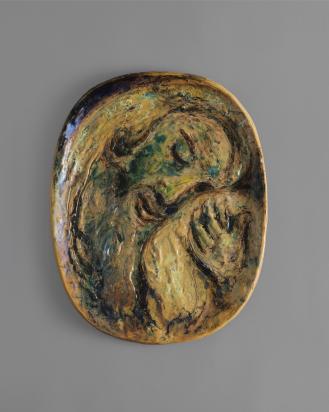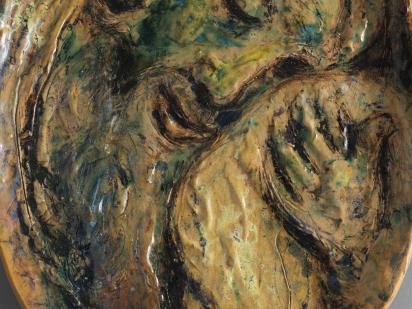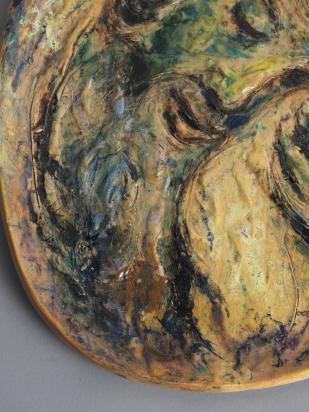Jacob's Dream is one of Chagall's first pieces in ceramic, a medium in which he began working in 1949. From 1950 to 1952, he made about 40 pieces with Biblical themes, including dishes, vases and plaques.1 They attest to the Bible’s essential role in his postwar work. In the early 1950s, Chagall began working on The Biblical Message for the Calvary Chapel in Vence. It was donated to the French state in 1966 and hung at the Marc Chagall National Museum2 in 1973. The ceramic works based on the Old Testament were made at the same time as the monumental Biblical Message paintings but are more intimate.
The iconography of this piece is different from traditional depictions of Jacob's dream, also known as "Jacob's ladder". The angels moving up and down the ladder in the dream are absent here. Only the stone that the patriarch put under his head before falling asleep at dusk on his way to Haran recalls the passage from the Book of Genesis. Jacob’s head, his eyes shut, takes up the entire space of the piece like a close-up shot in a movie, conferring an unprecedented modernity on the Biblical character and creating a close bond between him and the viewer. It is not so much the narrative as the dream’s mystery and intensity in its intimate, prophetic dimension that Chagall seems to want to share with the viewer. The spare composition remarkably suits the vibrancy of the material, from which Jacob struggles to break free in a movement out towards the world, almost enveloping the viewer. His face, beard, hands and the stone are in relief, with a barbotine decoration. Oxides in shades of brown, ochre, yellow and green, a host of nuances, evoke the arid desert soil in contact with the cool night air. Jacob's face recalls some of Rembrandt's portraits of old men, which Chagall revered and from which he drew inspiration, especially for his Biblical subjects. The treatment of the material, the movement of the relief and the shimmering colors may also echo Mikhail Vroubel's late 19th and early 20th century glazed majolica pieces, which sparked Western painters’ interest in ceramic art.
Bible stories were Chagall’s favorite themes in his paintings, sculpture ceramics. Unlike other modern artists,3 who tended towards abstraction, he carried on the tradition of sacred art.4 After the trauma of the Second World War, Chagall turned once again to the Old Testament, a singular text in its attempt to embrace human existence in its totality and fullness. The humanistic and poetic dimension of the first Hebrew civilization seemed to move him more than the religious aspect. Moreover, the surface treatment of this piece is not totally figurative, demonstrating his receptiveness to contemporary art.





